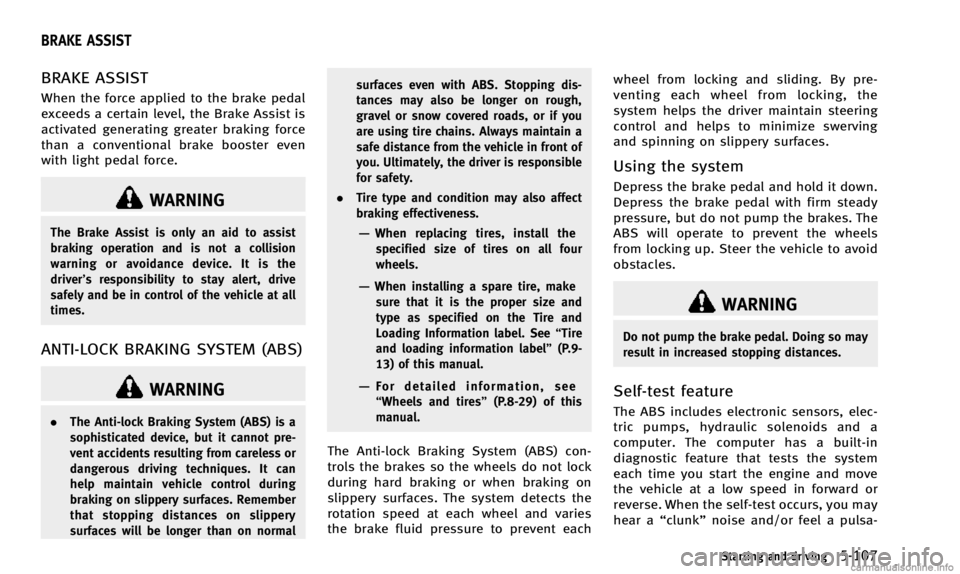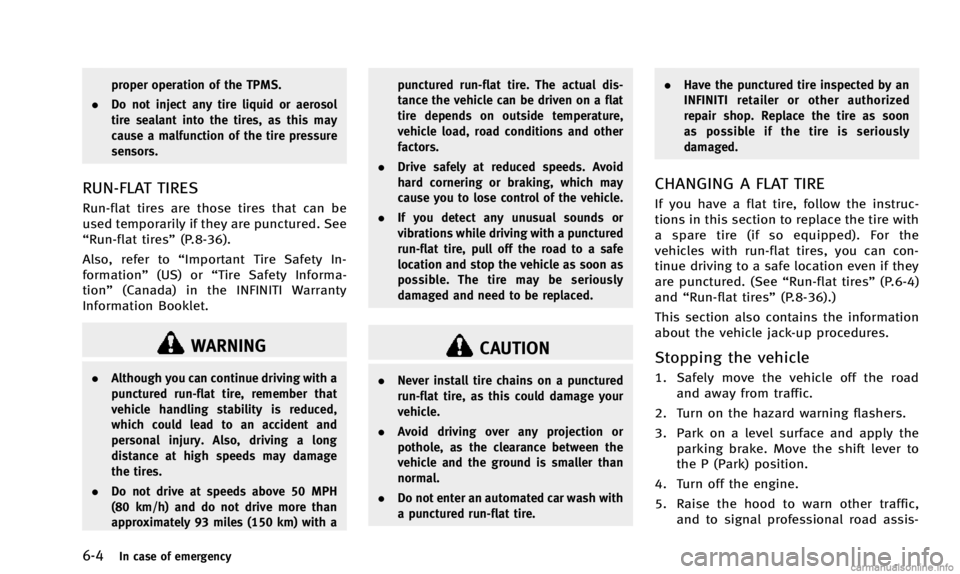sensor INFINITI Q50 2014 Workshop Manual
[x] Cancel search | Manufacturer: INFINITI, Model Year: 2014, Model line: Q50, Model: INFINITI Q50 2014Pages: 394, PDF Size: 1.99 MB
Page 266 of 394

WARNING
.The radar sensor does not detect the
following objects:
—Pedestrians, animals or obstacles in
the roadway
—Oncoming vehicles
—Crossing vehicles
. The radar sensor has some performance
limitations. For stationary vehicles, the
forward emergency braking system will
not function when the vehicle is driven
at speeds over approximately 45 MPH
(70 km/h).
. The radar sensor may not detect a
vehicle ahead in the following condi-
tions:
—Dirt, ice, snow or other material
covering the radar sensor.
—Interference by other radar sources.
—Snow or road spray from traveling
vehicles.
—If the vehicle ahead is narrow (e.g.motorcycle)
—When driving on a steep downhillslope or roads with sharp curves.
. In some road or traffic conditions, the
forward emergency braking system may
unexpectedly push the accelerator pedal
up or apply partial braking. When accel-
eration is necessary, continue to depress
the accelerator pedal to override the
system.
. Braking distances increase on slippery
surfaces.
. Excessive noise will interfere with the
warning chime sound, and the chime
may not be heard.
JVS0246X
Turning the forward emergency
braking system ON/OFF
Perform the following steps to turn the
forward emergency braking system on or
off.
1. Push the MENU button
*1and touch
[Driver Assistance] on the lower dis-
play.
2. Touch [Emergency Assist].
3. Touch [Forward emergency braking] to turn the system ON/OFF.
Starting and driving5-91
Page 267 of 394

5-92Starting and driving
JVS0299X
Forward emergency braking system warn-ing light (orange)
When the forward emergency braking
system is turned off, the forward emer-
gency braking system warning light (or-
ange) will illuminate.
The forward emergency braking system will
remain ON or OFF unless the setting is
changed on the lower display. This setting
is also linked with the log-in function. (See
“Log-in function” (P.3-14) and the Infiniti
InTouch Owner’ s Manual for the log-in
function.) NOTE:
When the forward emergency braking
system setting is turned ON or OFF, the
predictive forward collision warning sys-
tem is also turned ON or OFF simulta-
neously.
System temporarily unavailable
Condition A:
When the radar sensor picks up interfer-
ence from another radar source, making it
impossible to detect a vehicle ahead, the
forward emergency braking system is
automatically turned off. The forward
emergency braking system warning light
(orange) and the driver assist system
forward indicator (orange) will illuminate.
Action to take:
When the above conditions no longer exist,
the forward emergency braking system will
resume automatically.
Condition B:
When the sensor area of the front bumper
is covered with dirt or is obstructed,
making it impossible to detect a vehicle
ahead, the forward emergency braking
system is automatically turned off. The
forward emergency braking system warn-ing light (orange) and the driver assist
system forward indicator (orange) will
illuminate and the
“front radar obstruc-
tion” warning message will appear in the
vehicle information display.
Action to take:
If the warning light (orange) comes on,
park the vehicle in a safe place, and turn
the engine off. Clean the radar cover on
lower grille with a soft cloth, and restart
the engine. If the warning light continues
to illuminate, have the forward emergency
braking system checked by an INFINITI
retailer.
Condition C:
When the accelerator pedal actuator de-
tects that the internal motor temperature is
high, the forward emergency braking sys-
tem is automatically turned off. The for-
ward emergency braking system warning
light (orange) and the driver assist system
forward indicator (orange) will illuminate
and the “Unavailable High Accelerator
Temperature” warning message will appear
in the vehicle information display.
Page 268 of 394

Action to take:
When the above conditions no longer exist,
the forward emergency braking system will
resume automatically.
System malfunction
If the forward emergency braking system
malfunctions, it will be turned off auto-
matically, a chime will sound, the forward
emergency braking system warning light
(orange) and the driver assist system
forward indicator (orange) will illuminate
and the system“malfunction” warning
message will appear in the vehicle infor-
mation display.
Action to take:
If the warning light (orange) comes on,
park the vehicle in a safe location, turn the
engine off and restart the engine. If the
warning light continues to illuminate, have
the forward emergency braking system
checked by an INFINITI retailer.
Sensor maintenance
For the radar sensor maintenance, see
“Intelligent Cruise Control (ICC) system”
(P.5-58). FCC Notice:
For USA:
This device complies with Part 15 of the
FCC Rules. Operation is subject to the
following two conditions:
1.
This device may not cause harmful
interference, and
2. This device must accept any interfer-
ence received, including interference
that may cause undesired operation.
FCC Warning
Changes or modification not expressly
approved by the party responsible for
compliance could void the user’s authority
to operate the equipment.
For Canada:
This device complies with Industry Canada
licence-exempt RSS standard(s). Operation
is subject to the following two conditions:
1. This device may not cause interference,
and
2. This device must accept any interfer-
ence, including interference that may
cause undesired operation of the de-
vice.
Starting and driving5-93
Page 270 of 394

1. Driver assist system forward indicator
2. Vehicle ahead detection indicator
SYSTEM OPERATION
The predictive forward collision warning
system uses a radar sensor
*Alocated
behind the front bumper to measure the
distance to a second vehicle ahead in the
traveling lane. The predictive forward colli-
sion warning system operates at speeds
above approximately 3 MPH (5 km/h). If
there is a potential risk of a forward
collision, the predictive forward collision
warning system will warn the driver by
blinking the driver assist system forward
indicator and the vehicle ahead detection
indicator, and sounding a warning tone.
JVS0295X
Precautions on the predictive for-
ward collision warning system
WARNING
. The predictive forward collision warning
system is designed to warn you before a
collision but will not avoid a collision. It
is the driver’ s responsibility to stay
alert, drive safely and be in control of
the vehicle at all times.
. The radar sensor does not detect the
following objects:
—Pedestrians, animals or obstacles in
the roadway
—Oncoming vehicles
—Crossing vehicles
. The predictive forward collision warning
system does not function when a vehicle
ahead is a narrow vehicle, such as a
motorcycle.
. The radar sensor may not detect a
second vehicle ahead in the following
conditions:
—Snow or heavy rain
—Dirt, ice, snow or other material
covering the radar sensor
—Interference by other radar sources
—Snow or road spray from travelingvehicles is splashed
—Driving in a tunnel
Starting and driving5-95
Page 271 of 394

5-96Starting and driving
JVS0296X
JVS0297X
WARNING
.The radar sensor may not detect a
second vehicle when the vehicle ahead
is being towed.
. When the distance to the vehicle ahead
is too close, the beam of the radar
sensor is obstructed.
Page 272 of 394

JVS0298X
WARNING
.The radar sensor may not detect a
second vehicle when driving on a steep
downhill slope or on roads with sharp
curves.
. Excessive noise will interfere with the
warning tone sound, and it may not be
heard.
NOTE:
When the forward emergency braking
system setting is turned ON or OFF, the predictive forward emergency warning
system is also turned ON or OFF simulta-
neously.
JVS0299X
Forward emergency braking system warn-
ing light (orange)
System temporarily unavailable
Condition A:
When the radar sensor picks up interfer-
ence from another radar source, making it
impossible to detect a vehicle ahead, the
predictive forward collision warning sys-
tem is automatically turned off. The for-
ward emergency braking system warning
light (orange) and the driver assist system
forward indicator (orange) will illuminate.
Starting and driving5-97
Page 273 of 394

5-98Starting and driving
Action to take:
When the above conditions no longer exist,
the predictive forward collision warning
system will resume automatically.
Condition B:
When the sensor area of the front bumper
is covered with dirt or is obstructed,
making it impossible to detect a vehicle
ahead, the predictive forward collision
warning system is automatically turned
off. The forward emergency braking system
warning light (orange) and the driver assist
system forward indicator (orange) will
illuminate and the“front radar obstruc-
tion” warning message will appear in the
vehicle information display.
Action to take:
If the warning light (orange) comes on,
park the vehicle in a safe place, and turn
the engine off. Clean the radar cover on
lower grille with a soft cloth, and restart
the engine. If the warning light continues
to illuminate, have the predictive forward
collision warning system checked by an
INFINITI retailer.System malfunction
If the predictive forward collision warning
system malfunctions, it will be turned off
automatically, a chime will sound, the
forward emergency braking system warn-
ing light (orange) and the driver assist
system forward indicator (orange) will
illuminate, and the system malfunction
message will appear in the vehicle infor-
mation display.
Action to take:
If the warning light (orange) illuminates,
park the vehicle in a safe location, turn the
engine off and restart the engine. If the
warning light continues to illuminate, have
the predictive forward collision warning
system checked by an INFINITI retailer.
Sensor maintenance
For the radar sensor maintenance, see
“Intelligent Cruise Control (ICC) system”
(P.5-58).
FCC Notice:
For USA:
This device complies with Part 15 of the
FCC Rules. Operation is subject to the
following two conditions: 1.
This device may not cause harmful
interference, and
2. This device must accept any interfer-
ence received, including interference
that may cause undesired operation.
FCC Warning
Changes or modification not expressly
approved by the party responsible for
compliance could void the user’s authority
to operate the equipment.
For Canada:
This device complies with Industry Canada
licence-exempt RSS standard(s). Operation
is subject to the following two conditions:
1. This device may not cause interference,
and
2. This device must accept any interfer-
ence, including interference that may
cause undesired operation of the de-
vice.
Page 282 of 394

BRAKE ASSIST
When the force applied to the brake pedal
exceeds a certain level, the Brake Assist is
activated generating greater braking force
than a conventional brake booster even
with light pedal force.
WARNING
The Brake Assist is only an aid to assist
braking operation and is not a collision
warning or avoidance device. It is the
driver’s responsibility to stay alert, drive
safely and be in control of the vehicle at all
times.
ANTI-LOCK BRAKING SYSTEM (ABS)
WARNING
.The Anti-lock Braking System (ABS) is a
sophisticated device, but it cannot pre-
vent accidents resulting from careless or
dangerous driving techniques. It can
help maintain vehicle control during
braking on slippery surfaces. Remember
that stopping distances on slippery
surfaces will be longer than on normal surfaces even with ABS. Stopping dis-
tances may also be longer on rough,
gravel or snow covered roads, or if you
are using tire chains. Always maintain a
safe distance from the vehicle in front of
you. Ultimately, the driver is responsible
for safety.
. Tire type and condition may also affect
braking effectiveness.
—When replacing tires, install the
specified size of tires on all four
wheels.
—When installing a spare tire, make sure that it is the proper size and
type as specified on the Tire and
Loading Information label. See “Tire
and loading information label” (P.9-
13) of this manual.
—For detailed information, see “Wheels and tires” (P.8-29) of this
manual.
The Anti-lock Braking System (ABS) con-
trols the brakes so the wheels do not lock
during hard braking or when braking on
slippery surfaces. The system detects the
rotation speed at each wheel and varies
the brake fluid pressure to prevent each wheel from locking and sliding. By pre-
venting each wheel from locking, the
system helps the driver maintain steering
control and helps to minimize swerving
and spinning on slippery surfaces.
Using the system
Depress the brake pedal and hold it down.
Depress the brake pedal with firm steady
pressure, but do not pump the brakes. The
ABS will operate to prevent the wheels
from locking up. Steer the vehicle to avoid
obstacles.
WARNING
Do not pump the brake pedal. Doing so may
result in increased stopping distances.
Self-test feature
The ABS includes electronic sensors, elec-
tric pumps, hydraulic solenoids and a
computer. The computer has a built-in
diagnostic feature that tests the system
each time you start the engine and move
the vehicle at a low speed in forward or
reverse. When the self-test occurs, you may
hear a
“clunk” noise and/or feel a pulsa-
Starting and driving5-107
BRAKE ASSIST
Page 283 of 394

5-108Starting and driving
tion in the brake pedal. This is normal and
does not indicate a malfunction. If the
computer senses a malfunction, it switches
the ABS off and illuminates the ABS
warning light on the instrument panel.
The brake system then operates normally,
but without anti-lock assistance.
If the ABS warning light illuminates during
the self-test or while driving, have the
vehicle checked by an INFINITI retailer.
Normal operation
The ABS operates at speeds above 3 to 6
MPH (5 to 10 km/h).
When the ABS senses that one or more
wheels are close to locking up, the actuator
rapidly applies and releases hydraulic
pressure. This action is similar to pumping
the brakes very quickly. You may feel a
pulsation in the brake pedal and hear a
noise from under the hood or feel a
vibration from the actuator when it is
operating. This is normal and indicates
that the ABS is operating properly. How-
ever, the pulsation may indicate that road
conditions are hazardous and extra care is
required while driving.The Vehicle Dynamic Control (VDC) system
uses various sensors to monitor driver
inputs and vehicle motion. Under certain
driving conditions, the VDC system helps
to perform the following functions.
.
Controls brake pressure to reduce
wheel slip on one slipping drive wheel
so power is transferred to a non
slipping drive wheel on the same axle.
. Controls brake pressure and engine
output to reduce drive wheel slip based
on vehicle speed (traction control func-
tion).
. Controls brake pressure at individual
wheels and engine output to help the
driver maintain control of the vehicle in
the following conditions:
— understeer (vehicle tends to not
follow the steered path despite
increased steering input)
— oversteer (vehicle tends to spin due
to certain road or driving condi-
tions).
The VDC system can help the driver to
maintain control of the vehicle, but it
cannot prevent loss of vehicle control in
all driving situations.
When the VDC system operates, the VDC
warning light
in the instrument panel flashes so note the following:
.
The road may be slippery or the system
may determine some action is required
to help keep the vehicle on the steered
path.
. You may feel a pulsation in the brake
pedal and hear a noise or vibration
from under the hood. This is normal
and indicates that the VDC system is
working properly.
. Adjust your speed and driving to the
road conditions.
See “Vehicle Dynamic Control (VDC) warn-
ing light” (P.2-17).
If a malfunction occurs in the system, the
VDC warning light
illuminates in the
instrument panel. The VDC system auto-
matically turns off.
The VDC OFF switch is used to turn off the
VDC system. The VDC off indicator light
illuminates to indicate the VDC system is
off. When the VDC switch is used to turn off
the system, the VDC system still operates
to prevent one drive wheel from slipping by
transferring power to a non slipping drive
wheel. The VDC warning light
flashes if
this occurs. All other VDC functions are off,
except for brake force distribution, and the
VDC warning light
will not flash. The
VEHICLE DYNAMIC CONTROL (VDC) SYSTEM
Page 295 of 394

6-4In case of emergency
proper operation of the TPMS.
. Do not inject any tire liquid or aerosol
tire sealant into the tires, as this may
cause a malfunction of the tire pressure
sensors.
RUN-FLAT TIRES
Run-flat tires are those tires that can be
used temporarily if they are punctured. See
“Run-flat tires” (P.8-36).
Also, refer to “Important Tire Safety In-
formation” (US) or“Tire Safety Informa-
tion” (Canada) in the INFINITI Warranty
Information Booklet.
WARNING
. Although you can continue driving with a
punctured run-flat tire, remember that
vehicle handling stability is reduced,
which could lead to an accident and
personal injury. Also, driving a long
distance at high speeds may damage
the tires.
. Do not drive at speeds above 50 MPH
(80 km/h) and do not drive more than
approximately 93 miles (150 km) with a punctured run-flat tire. The actual dis-
tance the vehicle can be driven on a flat
tire depends on outside temperature,
vehicle load, road conditions and other
factors.
. Drive safely at reduced speeds. Avoid
hard cornering or braking, which may
cause you to lose control of the vehicle.
. If you detect any unusual sounds or
vibrations while driving with a punctured
run-flat tire, pull off the road to a safe
location and stop the vehicle as soon as
possible. The tire may be seriously
damaged and need to be replaced.
CAUTION
.Never install tire chains on a punctured
run-flat tire, as this could damage your
vehicle.
. Avoid driving over any projection or
pothole, as the clearance between the
vehicle and the ground is smaller than
normal.
. Do not enter an automated car wash with
a punctured run-flat tire. .
Have the punctured tire inspected by an
INFINITI retailer or other authorized
repair shop. Replace the tire as soon
as possible if the tire is seriously
damaged.
CHANGING A FLAT TIRE
If you have a flat tire, follow the instruc-
tions in this section to replace the tire with
a spare tire (if so equipped). For the
vehicles with run-flat tires, you can con-
tinue driving to a safe location even if they
are punctured. (See “Run-flat tires”(P.6-4)
and “Run-flat tires” (P.8-36).)
This section also contains the information
about the vehicle jack-up procedures.
Stopping the vehicle
1. Safely move the vehicle off the road and away from traffic.
2. Turn on the hazard warning flashers.
3. Park on a level surface and apply the parking brake. Move the shift lever to
the P (Park) position.
4. Turn off the engine.
5. Raise the hood to warn other traffic, and to signal professional road assis-